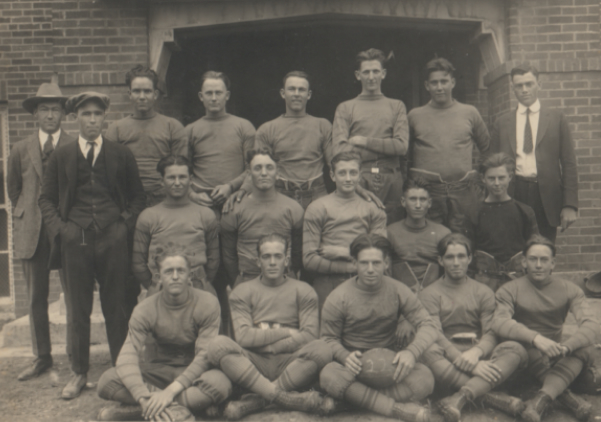Football Comes to Fredericksburg. (original) (raw)
Books by
Michael Barr
Order Here:
Long before it was time for a player to start the game by striking the ball with his toe (the kickoff), the "side liners" (sports fans) had already staked out their territory along the edge of the meadow (the gridiron). The Johnny-Come-Latelies jostled each other for standing room in the less desirable area (the cheap seats) behind the scoring region (the end zone).
Yes, the lingo was confusing, but that was understandable since most people who gathered that day in Fredericksburg had never seen a football game.
Baseball was huge in those days. Most people could name the heavy weight boxing champion. But football in the early 20th century was an obscure sport played by Ivy Leaguers between the last game of squash and the beginning of lacrosse season.
That all began to change in 1911 when a college freshman from Fredericksburg named Louis Jordan made the football team at the University of Texas. Four years later journalist Walter Camp listed Jordan on Camp's All-American football squad making Jordan one of the first players from below the Mason-Dixon line to be named All-American.
Louis Jordan sparked an interest in football in these parts. Friends and relatives of the Jordan family began making the trek to Austin to watch Jordan play. Each year the caravan got bigger, especially when the Longhorns played the Aggies in Austin on Turkey Day.
Slowly football crept into our collective consciousness. In August 1920 newspapers carried a story about a bunch of impoverished football fanatics who met in the showroom at Ralph Hay's Hupmobile dealership in Canton, Ohio and founded the National Football League.
Even money said the NFL wouldn't last til Christmas, but it outlived the Hupmobile and then some. (Today an NFL franchise is worth between 2billionand2 billion and 2billionand7 billion).
That fall the University Interscholastic League sponsored the first Texas high school football championship. Cleburne and Houston Heights pulverized each other to a scoreless tie.
The military played a key role in popularizing football. After WWI, regimental squads from bases in San Antonio played exhibition football games in surrounding towns.
Fredericksburg wanted to host an exhibition game for its Armistice Day celebration in 1921, but the event never happened. Spanish Flu was the likely culprit.
Meanwhile young people all over Gillespie County played informal games on sandlots and school playgrounds. Fredericksburg High School made plans to field a football team as soon as it could scrape up enough money for a ball and some uniforms.
Then in October 1923 the Fredericksburg Standard announced "Sport lovers of our town have the opportunity of witnessing the first game of football played in the town of Fredericksburg."

1925 Fredericksburg High School football team
Courtesy of the Gillespie County Historical Society
On October 21, 1923, a team of young men from Fredericksburg played the Kerrville All-Stars on a field in South Heights - a section of town across Barons Creek near Columbus Street.
Two weeks later, the Standard made another big announcement. "For the first time in the history of our High School, our local High School football team will play against the Kerrville High School football team."
The two rivals battled it out on November 8, 1923 in Fredericksburg on the field in South Heights.
For the record Kerrville won both games, but Fredericksburg was hooked on football.
The whole town got behind the local team. In 1925 Central Drug Company of Fredericksburg bought the guys a new ball. The team treasured that pigskin like Ebenezer Scrooge cherished a farthing.
Each year the team improved, and on November 27, 1925, FHS played Brady High School for the district championship. The game ended in a tie.
Then the news broke that Brady used an ineligible player, so the league declared Fredericksburg district champion.
With help from the Works Progress Administration the school built a football field with concrete bleachers on College Street. Local businessmen raised money for lights.
The school dedicated the new lighted field on November 3, 1939, before the Fredericksburg/Lampasas football game. Clyde Littlefield, legendary UT football and track coach and a Longhorn teammate of Louis Jordan, made the dedication speech.
With football now played on cool evenings during non-working hours, attendance soared.
It's been soaring ever since.
Sources:
"Fredericksburg Loses To Kerrville," Fredericksburg Standard, October 27, 1923.
"Football News," Fredericksburg Standard, November 3, 1923.
"Tied For District Title," Fredericksburg Standard, November 28, 1925.
"Fbg Hi Champion," Fredericksburg Standard, December 5, 1925.
"Hillbillies Limp In With 27-6 Victory Over Lampasas," Fredericksburg Standard, November 9, 1939.